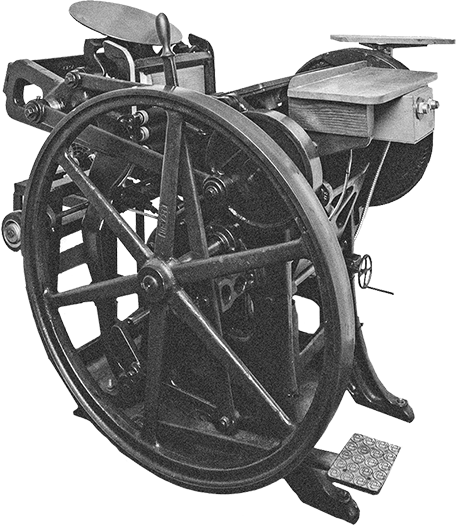A Guide to the Modern Letterpress Calling Card
by Evan Calkins -In the name of convenience, so many of our interactions have turned into fleeting, forgettable moments. At Hoban Cards, we hope to re-introduce the historical concept of the calling card as a much-needed token of authenticity. Today, the convenience of social media is undeniable, but a physical representation of you is more important than ever.
 One of our original calling cards templates, The Agent.
One of our original calling cards templates, The Agent.
Ever since I was introduced to letterpress printing, I’ve been fascinated and romanticized by simple type printed on quality paper. Admittedly, I’ve also looked longingly at the immensely beautiful and complex pieces other printers have been able to produce using these machines, but I always seem to fall back on the idea that the letterpress was meant to exemplify the intrinsic beauty of type.
The modern calling card is not only a physical item but an idea. To me, it’s almost the antithesis to the conventional business card because it celebrates a personal interaction instead of creating a business expectation. Historically, the calling card (or visiting card) was used to announce a visit, or serve as a memory of one. I believe the most important quality of the modern calling card can gracefully adopt this idea - an elegant token of a meaningful interaction.
In 2011 I launched the first iteration of Hoban Cards, which was a simple one-page storefront selling 6 calling card templates. It was originally an experiment to marry my fascination with typography and this philosophical idea of the anti business card. Since then, the site has grown to offer many more card options, but my original love for simple, thoughtfully designed letterpress printing has been maintained through it all.
As an accessory this idea, here are four distinct qualities that a modern calling card should retain:
 A custom calling cards we letterpress printed featured a blind (inkless) impression and a great type pairing.
A custom calling cards we letterpress printed featured a blind (inkless) impression and a great type pairing.
Calling Cards Represent People
The differences between a business card and a calling card are subtle, if not philosophical. Physically, there is no difference - they are both essentially a piece of paper with information that is exchanged. The difference is, a calling card should represent you as a person and not you as an employee. That’s not to say a calling card can’t contain business information, but the main focus of the card should be about a personality. Simply put, you are presenting yourself instead of being fronted by a business interest.
Calling Cards Should be Tasteful
I often hear about folks wanting to stand out when they order print materials. They want their materials to be unique and noticed. In this pursuit, I’ve seen many kitschy, over the top marketing materials that may work well for a traveling circus, but not as much for a professional individual. While I appreciate the design ingenuity of some of these stand out pieces, I wonder how they ultimately reflect on the giver.
To be unique is a fine motivation, but perhaps a better motivation is to be memorable. You may be surprised at how memorable an introduction can be when garnished by a simple calling card.
 Our Esquire template printed on black stock with metallic silver ink
Our Esquire template printed on black stock with metallic silver ink
Calling Cards Show you Care
A calling card should be somewhat special. It can serve as a small piece of artwork that reminds the receiver of the importance of your conversation - not just your contact information. It should become a token of a memorable exchange. Instead of haphazardly distributing your cards on an office desk or a convention booth, keep your calling cards with you. If the situation is appropriate, physically hand them to the folks you interact with. Conventional business cards are often discarded as soon as the relevant information is retained digitally, but a calling card should be hard to dispose of.
Calling Cards Should be Thoughtfully Typeset
Because our calling cards are intentionally designed without graphics or logos, the only design element represented is the type itself. For this reason, it’s especially important to consider a well-designed typeface. Even if you have no design sensibilities, selecting a classic, tried and true typeface is always a great place to start.
On our calling card, The Detective, I use one of my favorite typefaces, Cochin. It’s a typeface designed in 1912 and contains classic but distinctive glyphs. The card uses regular, bold and italic fonts to distinguish between the name, title and contact information. It’s a very simple layout, but the typeface makes it timeless.
 An up-close example of the letterpress impression on our Lyricist calling card.
An up-close example of the letterpress impression on our Lyricist calling card.
I still love designing and printing letterpress business cards, but my passion lies in these simple pieces of paper we call the calling card. There is something quite different that happens when you receive a calling card. They become a small gift that invites you into another’s life. There is no pressure to buy or sell, just a simple gesture to maintain a friendly relationship. The cards also have historic significance to an age before business cards were conceived. We hope to do our part to help this tradition continue and we feel there’s no better method to make that happen than letterpress printing timeless typography on quality paper.

Thanks for Reading!
We not only love writing about letterpress, typography, and design – we're printers ourselves! We've chosen to carry on the tradition of letterpress printing by offering beautifully pre-designed cards at affordable prices.